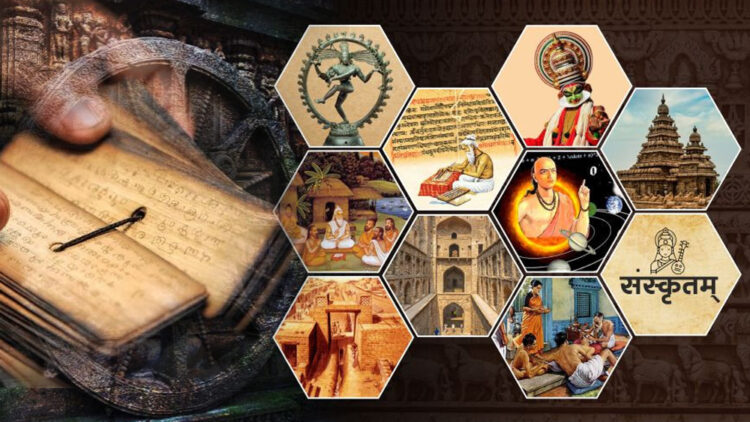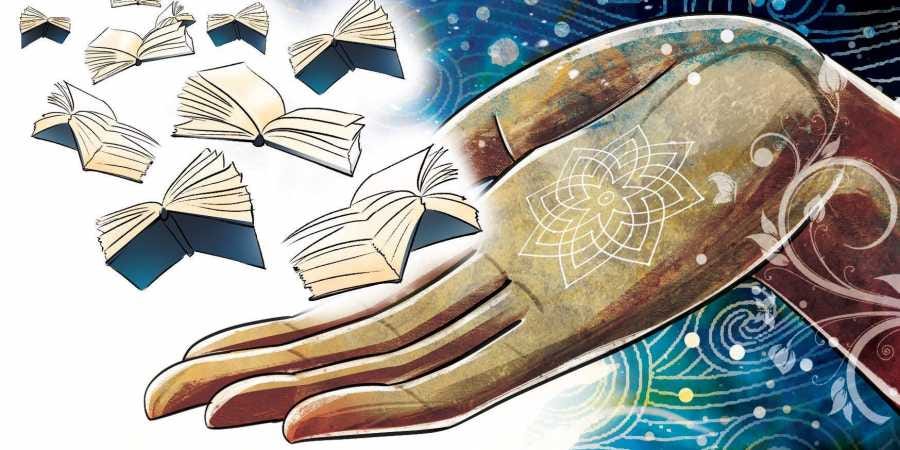Embarking on his professional journey, Vaibhav considered himself lucky to have Uncle Sivaranjan as a seasoned mentor. Sivaranjan, a Vice President of a major corporation, became a source of wisdom, providing insights beyond the confines of textbooks. With Sivaranjan’s guidance, Vaibhav felt well-prepared and self-assured as he entered the professional arena.
Vaibhav was nominated by his employer for a three-day Design Thinking program after a year on the job. The first day of the program left him puzzled, grappling to fully grasp the significance of Design Thinking in his evolving career. Seeking clarity, he reached out to his mentor, Uncle Sivaranjan. Up to this point, they have delved into the Overview of Design Thinking, Decoding Design Thinking, and Nurturing India’s Future through the Indian Knowledge System.
Sivaranjan walks Vaibhav through the history of Indian civilization and tells him it is a mosaic of diverse perspectives, beliefs, traditions, and cultures. It thrives on a multitude of interpretations and philosophies, all seamlessly interwoven into its societal framework. At the core of this framework lies the Indian Knowledge System (IKS), a repository of ancient wisdom that has evolved over centuries, offering abstruse insights into the art of living and societal harmony.
He further explains that the Indian Knowledge System, deeply rooted in the spiritual and philosophical traditions of the subcontinent, serves as a compass for individuals and communities. It is a holistic approach that extends beyond mere academic knowledge, encompassing the nuances of life, morality, and societal well-being. Within the vast expanse of the IKS, one finds timeless principles that provide a blueprint for fostering a society that is both peaceful and growth-oriented.
Sivaranjan: Vaibhav, the more we study the Indian Knowledge System, the more we will be able to draw the parallels between IKS and Design Thinking. It is exactly what we are going to do today. Let’s understand the roots of Design Thinking in the Indian Knowledge System.
Roots of Design Thinking in the Indian Knowledge System

Vaibhav: Uncle Sivaranjan, have you noticed the buzz around Design Thinking lately? It seems like everyone, from the corporates to governments, is hailing it as the ultimate problem-solving tool. Even here in India, especially in the IT and manufacturing sectors, it’s being embraced like a new messiah.
Sivaranjan: Yes, Vaibhav, it’s indeed fascinating how Design Thinking has taken center stage in problem-solving methodologies. But you know, when I reflect on it, it feels like a newborn in the vast landscape of India’s ancient knowledge.
Vaibhav: A newborn? What do you mean, Uncle?
Sivaranjan: Well, Design Thinking is essentially a ‘knowledge creation’ process. In the context of India, with its codified human knowledge for time immemorial, it’s like a recent addition to the family. Our thinkers and philosophers delved into details about people, objects, emotions, and existence. I wonder if our rich heritage has a lot to offer in this world of comprehensive problem-solving.
Vaibhav: That’s an interesting perspective, Uncle. I never thought about it that way. But, do you see any parallels between Design Thinking and our ancient wisdom?
Sivaranjan: Absolutely, Vaibhav. Design Thinking is about understanding a problem deeply and solving it creatively. Our ancient knowledge system too, with its holistic approach, is aimed at understanding situations and applying the relevant principles as per the time and space. It’s almost like our ancient thinkers laid the groundwork for a process like this.
Vaibhav: Can you give me an example?
Sivaranjan: Let’s say you’re exploring the philosophy of Advaita, which posits that there is only one reality, and everything else is an illusion. Initially, you find this philosophy intriguing and decide to delve deeper into its teachings. However, as you examine your own characteristics and circumstances, you realize that Advaita may not align with your current situation or resonate with your beliefs. At this point, you exercise your right to explore other philosophical paths. Perhaps you turn to Dvaita, which acknowledges the existence of a deity external to oneself, allowing for prayer and devotion as a means of achieving spiritual growth. While you may not fully adhere to either philosophy, you find that the concepts of Dvaita better suit your current needs and beliefs. You begin to study and incorporate these teachings into your life, embracing them as you navigate your journey as a householder (grahastha).
Vaibhav: That’s intriguing, Uncle. It’s like our ancient wisdom was already advocating a user-centered approach.
Sivaranjan: Exactly, Vaibhav. The parallel might not be direct, but the essence resonates. Our thinkers pondered over minute details of human experience, just like Design Thinking encourages a deep understanding of users and their needs.
Vaibhav: So, in a way, Design Thinking is not entirely new; it’s like a rediscovery of our age-old principles.
Sivaranjan: Precisely, Vaibhav. It’s a modern manifestation of our ancient wisdom, adapting to the evolving challenges of the world. As we explore Design Thinking, we may find that our roots run deeper than we initially thought.
Vaibhav: That’s interesting, Uncle Sivaranjan. I never realized our heritage could have such relevance in today’s problem-solving methodologies.
Sivaranjan: The beauty lies in the continuity of wisdom, Vaibhav. We stand on the shoulders of giants who contemplated the very essence of existence and problem-solving. It’s just a matter of connecting the dots between our ancient Indian knowledge and human-centric approaches like Design Thinking.
How does IKS resonate with the Design Thinking Principles?

Sivaranjan: When we put together the ancient knowledge system and modern problem-solving, the IKS harmoniously resonates with the principles of Design Thinking. Rooted in millennia-old philosophies, IKS offers timeless insights that seamlessly align with the innovative and empathetic approaches of Design Thinking. This convergence of traditional wisdom and today’s methodologies creates a holistic framework for addressing complex challenges and nurturing a society that blends ancient values with cutting-edge solutions.
Vaibhav: Can you share how Design Thinking aligns with the profound principles of the Indian Knowledge System (IKS)?
Compassion: The Yogic Perspective – Empathy
Sivaranjan: Absolutely, Vaibhav. Take compassion, for instance, rooted in the ancient wisdom of IKS, especially in Patanjali Yoga Sutra. In Design Thinking, understanding users’ needs is pivotal. The IKS principle of Maitri (friendship) aligns with the empathy we instill in our design process. Just like we consider joy, distress, virtuous aspects, and wisdom in IKS, Design Thinking also emphasizes understanding diverse perspectives to refine solutions.
Vaibhav: Interesting! So, it’s about not just reaching an objective but perfecting our understanding?
Sivaranjan: Exactly, Vaibhav. When we listen with Maitri (friendship), Mudita (joy and happiness in someone else’s success), and Karuna (kindness), we not only comprehend objectives but also enhance the perfection of our solutions. The IKS principles, articulated by Sage Patanjali, beautifully parallel the essence of diverse thinking in Design Thinking. It’s about embracing different perspectives for a refined outcome.
Vaibhav: Can you give a real-world example?
Sivaranjan: Certainly! Think of Karuna, compassion from Yoga Sutras, aligning with empathy in Design Thinking. Our forefathers emphasized kindness towards others, akin to Design Thinking’s emphasis on empathizing with users for effective solutions. Just as Maitri and Karuna guide us, Design Thinking promotes understanding and kindness in crafting solutions.
Vaibhav: So, it’s about understanding and empathy creating not just effective but refined solutions?
Sivaranjan: Absolutely, Vaibhav. It’s about infusing our design process with the timeless wisdom of IKS, creating solutions that not only work but are empathetic and refined in their essence.
Duty: Yamas and Niyamas – Define – boundaries
Sivaranjan: Duty, rooted in the Yamas and Niyamas of Sage Patanjali’s Yoga Sutra, is like the guiding principles in Design Thinking. These guidelines, applicable to seekers, householders, and retirees, align duties with one’s inherent characteristics or Gunas. It’s akin to Design Thinking adapting to diverse user needs and characteristics, and creating solutions that resonate with the unique qualities of individuals.
Vaibhav: So, it’s about tailoring duties based on characteristics?
Sivaranjan: Precisely. In IKS, duty is defined based on one’s behavior, and Design Thinking echoes this by adapting solutions to the diverse characteristics present in users. The flexibility of IKS allows for a spectrum of duties, much like Design Thinking’s adaptable approach to problem-solving.
Vaibhav: Can you elaborate on how this adaptability works in Design Thinking?
Sivaranjan: Think of it this way, Vaibhav. Design Thinking, like the IKS, embraces the uniqueness of each individual’s characteristics. When we define problems and seek solutions, it’s not a one-size-fits-all approach. Instead, Design Thinking acknowledges and adapts to the diverse paths, just like the flexible duties defined in IKS.
Vaibhav: So, it’s about creating solutions that resonate uniquely with each individual?
Sivaranjan: Absolutely. Whether it’s duties in IKS or solutions in Design Thinking, the emphasis is on recognizing and embracing the diversity present in the world. It’s about crafting solutions that resonate uniquely, ensuring they align seamlessly with the characteristics and needs of individuals.
Freedom: Embracing Diversity of Thought – Ideate
Sivaranjan: Absolutely, Vaibhav. In IKS, freedom isn’t just about personal space but extends to unshackling the mind during ideation. It aligns with the growth and sustenance values, emphasizing that real freedom comes when we shed ignorance.
Vaibhav: Interesting! So, how does this resonate with the Design Thinking process?
Sivaranjan: Well, in Design Thinking, we need that freedom to think beyond ‘my idea’ and embrace diverse thoughts. IKS encourages open-mindedness, and the scriptures provide the freedom to question and interpret, essential for ideation. But, Yogi Patanjali’s caution about hindrances is vital.
Vaibhav: So, it’s about not just embracing freedom but also being cautious about potential hurdles?
Sivaranjan: Precisely, Vaibhav. Freedom in ideation is about uninhibited thinking, but we need awareness to avoid hindrances. It’s a delicate balance that IKS beautifully guides us through.
Vaibhav: Fascinating! So, true freedom in ideation is when we are aware and open to diverse perspectives.
Sivaranjan: Absolutely! It’s the synergy of freedom, awareness, and diverse thinking that enriches the ideation process, aligning seamlessly with the principles embedded in IKS.
Choice: Philosophical Prototyping – Prototype
Sivaranjan: ‘Choice’ serves as a profound guide, highlighting hindrances rooted in IKS principles that can impede innovative thinking.
Sivaranjan: The first, Avidya is ignorance. Avidya manifests when people engage without understanding the core concepts. In Design Thinking, this lack of understanding hampers progress toward objectives.
Vaibhav: And Asmita, the self-centric attitude, how does that fit in?
Sivaranjan: Asmita revolves around personal concerns and fear of judgment, hindering open exchanges. In Design Thinking, addressing Asmita is crucial for fostering an environment where ideas flow freely.
Sivaranjan: Raga, the attachment to past successes, seems like a challenge. In Design Thinking, attachment to past ideas without considering their relevance can hinder innovation.
Sivaranjan: Dwesha, aversion, and strong opinions are a common challenge, in both contexts, strong opinions hinder open-mindedness and the free expression of ideas.
Sivaranjan: Abhinavesha, fear in conversations is a significant barrier. Fear inhibits creativity and open dialogue, crucial components of both Design Thinking and the broader IKS.
Vaibhav: So, ‘Choice’ is about liberating ourselves from these hindrances for innovative ideation?
Sivaranjan: Yes, Vaibhav. Embracing ‘Choice’ involves navigating these hindrances, akin to philosophical prototyping, enriching the ideation landscape, and fostering innovation.
Vaibhav: And, in a way, philosophical prototyping mirrors the adaptability emphasized in IKS?
Sivaranjan: Absolutely. Both encourage continuous learning and adaptation, emphasizing the journey over an elusive pursuit of perfection.
Reflection: Mananam and Continuous Improvement – Test
Sivaranjan: Mananam is like our continuous improvement process, involving self-analysis and learning from experiences. It’s analogous to testing in modern contexts.
Vaibhav: So, how does Mananam align with Design Thinking or continuous improvement?
Sivaranjan: Mananam is one of the four critical concepts in IKS, emphasizing feedback from various sources. In Design Thinking, feedback is crucial for iterative improvement. It involves analyzing feedback, identifying areas for improvement, and adding them to the continuous improvement backlog.
Vaibhav: Feedback from gurus is highlighted. How does that resonate with Design Thinking?
Sivaranjan: In both contexts, feedback from mentors or preceptors is invaluable. It signifies a connection to wisdom and guidance. In Design Thinking, mentor feedback is instrumental for personal and professional development.
Vaibhav: The five aspects of impact, from self to society and God, seem comprehensive.
Sivaranjan: Indeed, Vaibhav. Society provides insights into harmonious living, while gurus offer guidance. It mirrors the multi-dimensional feedback we seek in the design thinking process.
Vaibhav: So, this continuous improvement loop involves testing, reflecting, and self-improvement?
Sivaranjan: Absolutely. It’s an interaction between testing principles, reflecting on outcomes, and adapting behavior based on diverse feedback sources. This holistic approach embedded in IKS provides a timeless guide for personal and societal advancement, aligning seamlessly with the principles of continuous improvement in Design Thinking.
Vaibhav: Uncle, it’s fascinating how the ancient principles we discussed align seamlessly with modern concepts of Design Thinking. The iterative nature, rooted in teachings like Patanjali Yoga Sutra, not only provides a philosophical foundation but also resonates with the core of design thinking and personal growth.
Sivaranjan: Absolutely, Vaibhav. The acknowledgment of diverse philosophies and the pursuit of continuous learning, evident in both, showcase the adaptability ingrained in the Indian knowledge system.
Vaibhav: It’s like a continuous loop of testing ideas, reflecting on outcomes, and adapting based on feedback, creating an environment where diverse thoughts flourish.
Sivaranjan: True, Vaibhav. These principles serve as a beacon for navigating complexities, not just in Design Thinking but in life, fostering an enlightened future.
Vaibhav: Embracing this adaptability and time-tested wisdom, we can truly enrich our design thinking processes and interactions in life.
Sivaranjan: Well said, Vaibhav. It’s about finding harmony between ancient principles and modern complexities.
https://www.linkedin.com/pulse/drawing-parallels-between-design-thinking-nuggets-our-aashish-koul/
https://sdtp.co.uk/decoding-design-thinking/
https://miro.medium.com/v2/resize:fit:900/0*KqU9O0MibGEAA4f-.jpg
https://indiacsr.in/wp-content/uploads/2022/05/Indian-Knowledge-System.jpg
https://english.janamtv.com/wp-content/uploads/2023/12/iks-wiki-750×422-1.jpg
Written By: Dr. Jimmy Jain and Pavan Valluri
Edited By: Afreen Fatima
Society of Design Thinking Professionals









